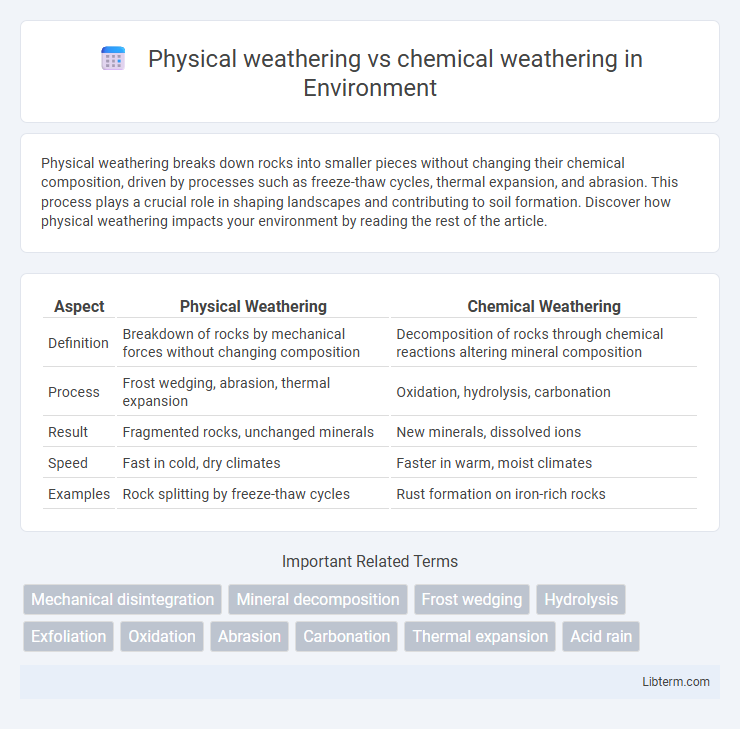Physical weathering breaks down rocks into smaller pieces without changing their chemical composition, driven by processes such as freeze-thaw cycles, thermal expansion, and abrasion. This process plays a crucial role in shaping landscapes and contributing to soil formation. Discover how physical weathering impacts your environment by reading the rest of the article.
Table of Comparison
| Aspect | Physical Weathering | Chemical Weathering |
|---|---|---|
| Definition | Breakdown of rocks by mechanical forces without changing composition | Decomposition of rocks through chemical reactions altering mineral composition |
| Process | Frost wedging, abrasion, thermal expansion | Oxidation, hydrolysis, carbonation |
| Result | Fragmented rocks, unchanged minerals | New minerals, dissolved ions |
| Speed | Fast in cold, dry climates | Faster in warm, moist climates |
| Examples | Rock splitting by freeze-thaw cycles | Rust formation on iron-rich rocks |
Introduction to Weathering
Physical weathering involves the mechanical breakdown of rocks into smaller fragments without changing their chemical composition, commonly caused by temperature fluctuations, freeze-thaw cycles, and abrasion. Chemical weathering alters the mineral composition of rocks through reactions with water, oxygen, acids, and other chemicals, leading to dissolution, oxidation, or hydrolysis. Understanding the distinctions between physical and chemical weathering is essential for analyzing soil formation, landscape development, and mineral resource distribution.
Definition of Physical Weathering
Physical weathering refers to the mechanical breakdown of rocks into smaller fragments without altering their chemical composition. Processes such as freeze-thaw cycles, abrasion, and thermal expansion cause rocks to fracture and disintegrate through physical forces. This type of weathering increases surface area, facilitating further weathering and erosion.
Definition of Chemical Weathering
Chemical weathering is the breakdown of rocks and minerals through chemical reactions, altering their composition and structure. This process includes hydrolysis, oxidation, and carbonation, which chemically transform original materials into new substances. Unlike physical weathering, chemical weathering changes the mineralogical characteristics, contributing to soil formation and landscape evolution.
Key Differences Between Physical and Chemical Weathering
Physical weathering breaks down rocks through mechanical processes like freezing and thawing, abrasion, and thermal expansion, without altering the rock's chemical composition. Chemical weathering involves the transformation of minerals within rocks through chemical reactions such as oxidation, hydrolysis, and carbonation, leading to the formation of new minerals and soluble substances. Key differences include the nature of the process--mechanical versus chemical alteration--and the impact on rock composition, where physical weathering causes fragmentation while chemical weathering changes the mineralogical structure.
Common Processes of Physical Weathering
Common processes of physical weathering include freeze-thaw cycles, where water infiltrates cracks, freezes, expands, and breaks rock apart, and thermal expansion, which causes rock layers to fracture due to temperature fluctuations. Abrasion from wind, water, or ice movement also contributes significantly by wearing down rock surfaces. Biological activity, such as root growth, exerts pressure that further fractures and disintegrates rock material in physical weathering.
Typical Processes of Chemical Weathering
Chemical weathering involves processes like hydrolysis, oxidation, and carbonation that alter the mineral composition of rocks by breaking down their chemical bonds. Hydrolysis transforms feldspar minerals into clay minerals through reaction with water, while oxidation causes iron-bearing minerals to form rust-like oxides, weakening the rock. Carbonation reacts carbon dioxide with water to form carbonic acid, which dissolves carbonate rocks such as limestone, accelerating rock decomposition and soil formation.
Factors Influencing Physical Weathering
Physical weathering is driven primarily by temperature fluctuations, freeze-thaw cycles, and mechanical forces such as wind and water abrasion that break down rocks without altering their chemical composition. Rock type, texture, and presence of joints or fractures significantly influence the rate and extent of physical weathering. Environmental conditions, including climate variability and moisture availability, also play crucial roles in accelerating or inhibiting the physical disintegration of rock materials.
Factors Influencing Chemical Weathering
Chemical weathering is significantly influenced by factors such as temperature, moisture, and the presence of acidic conditions, which accelerate the breakdown of minerals through chemical reactions. Higher temperatures increase reaction rates, while abundant water facilitates hydrolysis, oxidation, and dissolution processes essential for chemical alteration. Soil pH and the availability of carbon dioxide further enhance chemical weathering by promoting acid formation that dissolves rock components more effectively.
Real-World Examples of Physical and Chemical Weathering
Physical weathering is exemplified by freeze-thaw cycles in mountainous regions, where water infiltrates cracks, freezes, expands, and breaks rocks apart, such as in the Rocky Mountains. Chemical weathering occurs prominently in tropical rainforests, where high humidity and warm temperatures accelerate the breakdown of minerals through hydrolysis and oxidation, evident in the deep soil profiles of the Amazon Basin. These processes shape diverse landscapes by altering rock structure and mineral composition through mechanical disintegration and chemical transformation.
The Importance of Weathering in Earth’s Systems
Physical weathering breaks down rocks through mechanical processes such as freeze-thaw cycles and abrasion, increasing surface area and facilitating chemical reactions. Chemical weathering alters minerals in rocks through reactions with water, oxygen, and acids, leading to the formation of new minerals and releasing essential nutrients like calcium and potassium into soils. These weathering processes are crucial in Earth's systems by supporting soil formation, influencing biogeochemical cycles, and regulating landscape evolution and ecosystem productivity.
Physical weathering Infographic

 libterm.com
libterm.com